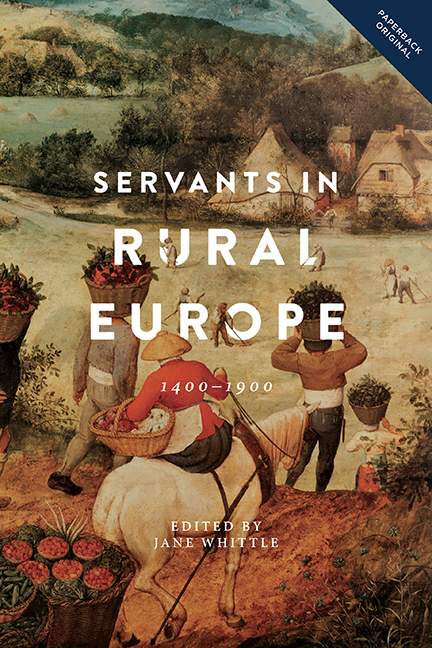Book contents
- Frontmatter
- Contents
- List of Figures
- List of Tables
- Note on Terminology
- List of Contributors
- Introduction: Servants in the Economy and Society of Rural Europe
- 1 The Employment of Servants in Fifteenth- and Sixteenth-Century Coastal Flanders: A Case Study of Scueringhe Farm near Bruges
- 2 The Institution of Service in Rural Flanders in the Sixteenth Century: A Regional Perspective
- 3 A Different Pattern of Employment: Servants in Rural England c.1500–1660
- 4 Female Service and the Village Community in South-West England 1550–1650: The Labour Laws Reconsidered
- 5 Life-Cycle Servant and Servant for Life: Work and Prospects in Rural Sweden c.1670–1730
- 6 Servants in Rural Norway c.1650–1800
- 7 Rural Servants in Eighteenth-Century Münsterland, North- Western Germany: Households, Families and Servants in the Countryside
- 8 Rural Servants in Eastern France 1700–1872: Change and Continuity Over Two Centuries
- 9 The Servant Institution During the Swedish Agrarian Revolution: The Political Economy of Subservience
- 10 Farm Service and Hiring Practices in Mid-Nineteenth-Century England: The Doncaster Region in the West Riding of Yorkshire
- 11 Dutch Live-In Farm Servants in the Long Nineteenth Century: The Decline of the Life-Cycle Service System for the Rural Lower Class
- 12 Rural Life-Cycle Service: Established Interpretations and New (Surprising) Data – The Italian Case in Comparative Perspective (Sixteenth to Twentieth Centuries)
- Select Bibliography
- Index
- People, Markets, Goods: Economies and Societies in History
5 - Life-Cycle Servant and Servant for Life: Work and Prospects in Rural Sweden c.1670–1730
Published online by Cambridge University Press: 18 April 2018
- Frontmatter
- Contents
- List of Figures
- List of Tables
- Note on Terminology
- List of Contributors
- Introduction: Servants in the Economy and Society of Rural Europe
- 1 The Employment of Servants in Fifteenth- and Sixteenth-Century Coastal Flanders: A Case Study of Scueringhe Farm near Bruges
- 2 The Institution of Service in Rural Flanders in the Sixteenth Century: A Regional Perspective
- 3 A Different Pattern of Employment: Servants in Rural England c.1500–1660
- 4 Female Service and the Village Community in South-West England 1550–1650: The Labour Laws Reconsidered
- 5 Life-Cycle Servant and Servant for Life: Work and Prospects in Rural Sweden c.1670–1730
- 6 Servants in Rural Norway c.1650–1800
- 7 Rural Servants in Eighteenth-Century Münsterland, North- Western Germany: Households, Families and Servants in the Countryside
- 8 Rural Servants in Eastern France 1700–1872: Change and Continuity Over Two Centuries
- 9 The Servant Institution During the Swedish Agrarian Revolution: The Political Economy of Subservience
- 10 Farm Service and Hiring Practices in Mid-Nineteenth-Century England: The Doncaster Region in the West Riding of Yorkshire
- 11 Dutch Live-In Farm Servants in the Long Nineteenth Century: The Decline of the Life-Cycle Service System for the Rural Lower Class
- 12 Rural Life-Cycle Service: Established Interpretations and New (Surprising) Data – The Italian Case in Comparative Perspective (Sixteenth to Twentieth Centuries)
- Select Bibliography
- Index
- People, Markets, Goods: Economies and Societies in History
Summary
Brita Olofsdotter died in 1713 in the very same house in which she had been born seventy-three years earlier. Being born to a freeholder family, and with both parents alive during her youth, she and her five brothers had had a good start in life. Her parents also provided her with some of the social capital she would come to need in life; according to a notation in a church register they had given her an ‘honest Christian upbringing’ and made sure she learned to read her Bible. Her two oldest brothers stayed with their parents and in time they took over the farm and formed families of their own. As both daughters and sons inherited real estate by Swedish law (if the parents owned any), Brita inherited a sister's part of the farm. She did not, however, stay at the farm in the parish Moklinta. Instead she became a live-in servant ‘in her youth’. But unlike the majority of women in her position Brita never married and she stayed in the service of others for most of her life. By the turn of the century she moved back home to her relatives in Moklinta. Then she turns up in the records as a lodger in the house of her younger brother Erik. When she eventually died she did so in the house of her (older) brother's grandson, Anders Eriksson. It is likely that her claim in the farm was never realized into real estate or money but instead used as an insurance of care and a home in her old age. Even so, after her death the local priest noted that she had received help from the parish poverty funds. The life as a live-in servant did not, in the end, provide Brita with enough savings to live out her life independently or as comfortably as she might have wished.
European early modern live-in servants have, as a group, been categorized as young, unmarried, dependent, subordinate and vulnerable. The work they performed has been labelled as unskilled and the time they spent as a live-in servant has been perceived as no more than a phase in their life cycle.
- Type
- Chapter
- Information
- Servants in Rural Europe1400–1900, pp. 95 - 112Publisher: Boydell & BrewerPrint publication year: 2017



